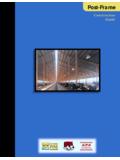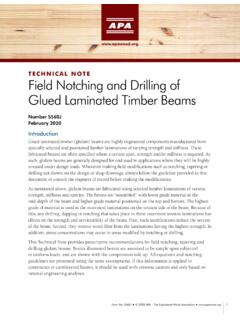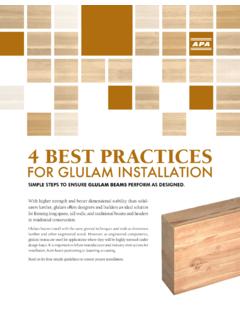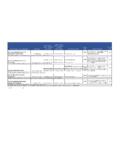Transcription of Technical Note: Preservative Treatment of Glued …
1 Technical noTe Number S580D July 2013inTroducTionStructural Glued laminated timbers (glulam) bearing the APA EWS trademark are produced by members of APA The Engineered Wood Association. These glulam timbers are manufactured to conform with ANSI Standard , American National Standard for Structural Glued Laminated Timber.(1)Although glulam does not require Preservative Treatment for most uses, certain applications may present environmental conditions conducive to decay, insect or marine borer attack, such as the long-term or frequent presence of moisture (generally 20 percent or greater moisture content of the wood) accompanied by temperatures ranging from 50 F to 90 F. Decay slows at temperatures outside this range and virtually ceases at temperatures below 35 F or above 100 conducive to decay or insect attack are typically controlled through recognized design principles and construction techniques, such as use of overhangs, flashings, ventilation and proper joint connection details.
2 When these conditions cannot be avoided, glulam must be pressure- Preservative -treated or a naturally durable wood species must be used. Examples of construction where such hazards may exist include direct exposure to weather, ground contact (including direct contact with concrete foundations and footings), contact with fresh water or sea water and exposure to excessive uses of Preservative -treated glulam include bridges, utility structures, marine applications, highway noise barriers and decks. Indoor uses that may require pressure Treatment include environments subject to high humidity or condensation such as indoor swimming pools or greenhouses, where moisture content of the wood may exceed 20 percent. Indoor applications, such as post-frame construction in some agricultural buildings, may also involve ground contact, and thus require Preservative Treatment for those members in contact with the STandardSApplicable standards for Preservative Treatment of glulam include American Wood Protection Association (AWPA) Standards U1(2) (and all other standards referenced therein) and M4.
3 (3) Related specifications include National Design Specification for Wood Construction (NDS)(4); ANSI (1); and Standard Specification for Transportation Materials and Methods of Sampling and Testing.(5) Preservative Treatment of Glued Laminated TimberPreservative Treatment of Glued Laminated TimberForm No. EWS S580D 2013 APA The Engineered Wood Association end-uSe Service condiTionSThe American Wood Protection Association (AWPA) has replaced the Commodity (C) Standards with the Use Category System (UCS). Service conditions are now designated into five basic use categories in AWPA Standard U1.(2) The use categories designations and service conditions that apply to glulam are summarized in Table that special attention should be paid when specifying Preservative treatments for use in areas subject to Formosan subterranean termite activities. For a list of suitable preservatives, please refer to AWPA Standard U1.(2) When specifying the use of Preservative -treated glulam in the state of Hawaii, confirm with city and county build-ing codes that the specified Preservative treatments meet the requirements for structural 1 SUMMARY OF USE CATEGORIES FOR TREATED WOODUse CategoryService Conditions Use EnvironmentCommon Agents of DeteriorationTypical ApplicationsUC1 Interior DryInterior construction, above ground, dryContinuously protected from weather or other sources of moistureInsects onlyInterior construction and furnishingsUC2 Interior DampInterior construction, above ground, dampProtected from weather, but may be subject to sources of moistureDecay fungi and insectsInterior construction UC3A(a)
4 Above Ground ProtectedExterior construction, above ground, coated and rapid water run-offExposed to all weather cycles, not exposed to prolonged wettingDecay fungi and insectsCoated millwork, siding and trimUC3B Above Ground ExposedExterior construction, above ground, uncoated or poor water run-offExposed to all weather cycles, including prolonged wetting Decay fungi and insectsDecking, deck joist, railings, fence pickets, uncoated millworkUC4A Ground Contact General UseGround contact or freshwater, non-critical componentsExposed to all weather cycles, normal exposure conditionsDecay fungi and insectsFence, deck and guardrail posts, cross-ties and utility poles (low decay areas)UC4B Ground Contact Heavy DutyGround contact or freshwater, critical components or difficult replacementExposed to all weather cycles, high decay potential includes saltwater splash Decay fungi and insects with increased potential for biodeteriorationPermanent wood foun-dations, building poles, horticultural posts, cross-ties and utility poles (high decay areas)UC4C Ground Contact Extreme DutyGround contact or fresh- water, critical structural componentsExposed to all weather cycles, severe environ-ments, extreme decay potential Decay fungi and insects with extreme potential for biodeteriorationLand and freshwater piling, foundation piling, cross-ties and utility poles (severe decay areas)UC5A Marine Use Northern WatersSalt or brackish water and adjacent mud zoneNorthern watersContinuous marine exposure (saltwater)
5 Saltwater organismsPiling, bulkheads, bracingUC5B Marine Use Central WatersSalt or brackish water and adjacent mud zoneNew Jersey to Georgia, south of San FranciscoContinuous marine exposure (saltwater)Saltwater organisms, including creosote tolerant Limnoria tripunctataPiling, bulkheads, bracingUC5C Marine Use Southern WatersSalt or brackish water and adjacent mud zoneSouth of Georgia, Gulf Coast, Hawaii and Puerto RicoContinuous marine exposure (saltwater)Saltwater organisms, including creosote tolerant Martesia and SphaeromaPiling, bulkheads, bracing(a) UC3A is not covered in AWPA Standard U1 for Treatment of Glued Laminated TimberForm No. EWS S580D 2013 APA The Engineered Wood Association treatments listed in AWPA Standard U1(2) for glulam include creosote, pentachlorophenol, copper naphthenate, oxine copper and waterborne inorganics. Proprietary Preservative treatments that meet AWPA require-ments and local building department approvals are permitted for PreservativesOrganic preservatives listed in AWPA Standard U1 include creosote, penta chlorophenol, copper naphthenate and oxine copper.
6 The first two are restricted use chemicals and not available for residential construction. Creosote is a coal tar product which is dissolved in a distilled solution or petroleum oil. It is an effective Preservative in commercial, industrial or marine applications when there is severe exposure to decay or insect attack, or marine borers in saltwater environments. Creosote-treated glulam has an odor and a dark, oiled surface appearance and, therefore, is not recommended where painting is (penta) is commonly dissolved in light petroleum oil or solvent, liquid petroleum gas (LPG), or in a petroleum solvent/water solution. It is suitable as a Preservative for ground contact or above-ground uses. Glulam treated with penta has an odor, and oil-borne penta has an oiled surface appearance and, thus, is not recommended for painting. Glulam treated with solvent- or water-borne penta (including penta in LPG), however, has an oil-free surface and natural wood appearance, and should be specified where staining or painting is desired.
7 Copper naphthenate (CuN) is suitable for above-ground uses and ground contact when treated to a proper retention level. CuN is often dissolved in heavy oil solvents or light hydrocarbon solvents for use as Preservative carriers. CuN-treated wood may have a light green coloration that diminishes during weathering. After thorough drying, it can be stained or painted, but a stain-blocking primer is recommended for finishing to minimize discoloration of the finish by the CuN copper (Cu8) is suitable for above-ground use. The Preservative is dissolved in liquid petroleum gas or light hydrocarbon solvents so that the treated glulam has a clear surface and is free of solvent odor. Oxine copper solutions may leave a greenish-brown coloration that could weather to gray. Glulam treated with oxine copper solutions may be stained or painted with an oil base finish after thorough PreservativesWaterborne treatments such as acid copper chromate (ACC), ammoniacal copper zinc arsenate (ACZA), alkaline copper quat-type-C (ACQ-C) and chromated copper arsenate (CCA) are not recommended by APA for glulam timbers that are to be treated after gluing, but may be applied to southern pine laminations prior to gluing.
8 Check with the glulam manufacturer and treater to verify the availability of these treatments. CCA may only be used in applications where frequent human contact will not occur. Consult with local and state building codes prior to specifying the use of CCA-treated wood. When waterborne treatments are specified for glulam after gluing, the members must be redried after treating. This process may cause dimensional changes, such as warping and twisting, or may lead to excessive checking, splitting or raised grain, resulting in a finished product with an unacceptable Treatment of Glued Laminated TimberForm No. EWS S580D 2013 APA The Engineered Wood Association treatments and processes specified should be agreed to by purchaser, seller and the governing code body. Required retention and penetration levels depend on end use and exposure according to AWPA U1 or other applicable specifications. Table 2 provides a summary of these Treatment characteristics and 2 Treatment TYPE CHARACTERISTICSC reosotePenta in OilsPenta in Light SolventsCopper Naphthenate (CuN)Oxine Copper (Cu8)Waterborne PreservativesSuitable ApplicationsSaltwater or freshwater applications, wood block floor, bridges, towers and ground , ground contact, above-ground uses, including docks, bridges, towers and contact and above-ground uses, should not be used in direct contact with use water applications and ground contact.
9 May be used indoors provided sawdust and construction debris are cleaned up and disposed by ordinary trash , oily , may be blotchy, may have from natural appear-ance of wood to some darkening of green coloration that may diminish during from natural appear-ance of wood to some darkening of to brown depending on chemicals used and exposure to be finished with water repel-lent or oil-based semi- transparent be stained or painted after thorough be finished with an oil-based stain or be stained or painted when surface is dry and prepared in accor-dance with coating manufacturer s not be used in residen-tial interiors. May be used in industrial interiors when two coats of effective sealer are be used in residential, indus-trial or commercial interiors as laminated beams or building components that are in ground contact and where two coats of effective sealer are develop greenish discoloration, of light-colored finishes. Stain-blocking primer or second topcoat is recommended for finishing to minimize potential discoloration by the Treatment .
10 Check with supplier for use in high decay hazard primer will help to minimize discoloration. May be used in residential interiors where frequent human contact will not develop green-ish discolor ation of finish. Stain-blocking primer will help to minimize discolor-ation. Surfaces may have raised grain and extensive checking may Treatment of Glued Laminated TimberForm No. EWS S580D 2013 APA The Engineered Wood Association r ecommendaTionSGlulam timbers are available in custom and stock sizes. Stock sizes are typically cut to length at a distribution center or on the job site. Most glulam to be pressure-treated will be in custom sizes and should be ordered to exact dimensions when possible to avoid field cuts, which must be retreated. In addition, all fabrication, cutting and predrilling of holes for fasteners is recommended prior to pressure may be treated after gluing or the individual laminations may be treated prior to gluing, depending on the wood species and Treatment specified.














